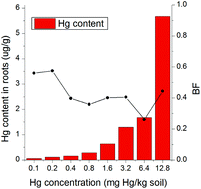Microarray analysis and real-time PCR assay developed to find biomarkers for mercury-contaminated soil†
Abstract
The evaluation of mercury (Hg) toxicity in agricultural soil is of great concern because its bioavailability and bioaccumulation in organisms through the food chain can have adverse effects on human health. Therefore, the aim of this study was to develop sensitive biomarkers for Hg stress in agricultural soil. With the results obtained from a high-throughput cDNA microarray, 12 Hg-responsive genes were selected to examine their concentration-dependent responses to Hg stress at different Hg concentrations. The lowest observable adverse effect concentrations (LOAECs) of Hg were 0.8 mg kg−1 for seed germination, 1.6 mg kg−1 for root biomass, 0.8 mg kg−1 for root elongation, and 0.8 mg kg−1 for root morphology, respectively, whereas the lowest Hg treatments (0.1–0.4 mg kg−1) could generally induce differential expression of genes. These results indicated that the detection of Hg in soil at the molecular level is a highly sensitive method. Moreover, the Hg soil content exhibited a significant positive correlation with the relative expression of probable glutathione S-transferase parA (r = 0.637, p = 0.05), chlorophyll a–b binding protein 13, chloroplastic-like (r = 0.689, p = 0.05) and geranylgeranyl pyrophosphate synthase 1 (r = 0.682, p = 0.05), implying that the three genes are good candidates to detect Hg-contaminated soil.


 Please wait while we load your content...
Please wait while we load your content...